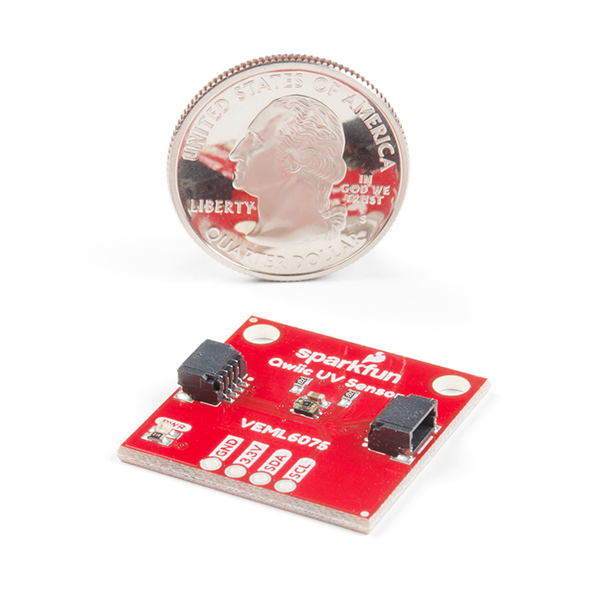SparkFun UV Light Sensor Breakout - VEML6075 (Qwiic)
The VEML6075 UV Light Sensor Breakout is SparkFun’s latest ultraviolet sensing solution. The VEML6075 implements a simple photodiode to measure the levels of UVA (320-400nm) and UVB (280-320nm) radiation. With this breakout, you will be able to read the intensity of these types of light in irradiance, and from there, calculate the UV Index. Utilizing our handy Qwiic system, no soldering is required to connect it to the rest of your system. However, we still have broken out 0.1"-spaced pins in case you prefer to use a breadboard.
The UV Light Sensor Breakout has two spectrum ranges of measurement, UVA (365 ±10nm), and UVB (330 ±10nm) and is capable of converting ultraviolet light intensity to digital data for you to read. The VEML6075 features a simple I2C interface, making it perfect for our Qwiic Connect System, while at the same time not requiring any voltage translation.
We've also written an Arduino library for the VEML6075 Breakout in order for you to begin reading UV sensor data even faster!
The SparkFun Qwiic Connect System is an ecosystem of I2C sensors, actuators, shields and cables that make prototyping faster and less prone to error. All Qwiic-enabled boards use a common 1mm pitch, 4-pin JST connector. This reduces the amount of required PCB space, and polarized connections mean you can’t hook it up wrong.
The VEML6075 UV Light Sensor Breakout can also be automatically detected, scanned, configured, and logged using the OpenLog Artemis datalogger system. No programming, soldering, or setup required!
- Operating Voltage: 1.7V-3.6V
- Supply Current: 480 µA
- UVA Resolution: 0.93 counts/µW/cm2
- UVA Resolution: 2.1 counts/µW/cm2
- 2x Qwiic Connectors
- I2C Address: 0x10
SparkFun UV Light Sensor Breakout - VEML6075 (Qwiic) Product Help and Resources
Qwiic UV Sensor (VEML6075) Hookup Guide
December 20, 2018
Learn how to connect your VEML6075 UV Sensor and figure out just when you should put some sunscreen on.
Core Skill: Programming
If a board needs code or communicates somehow, you're going to need to know how to program or interface with it. The programming skill is all about communication and code.
Skill Level: Competent - The toolchain for programming is a bit more complex and will examples may not be explicitly provided for you. You will be required to have a fundamental knowledge of programming and be required to provide your own code. You may need to modify existing libraries or code to work with your specific hardware. Sensor and hardware interfaces will be SPI or I2C.
See all skill levels
Core Skill: Electrical Prototyping
If it requires power, you need to know how much, what all the pins do, and how to hook it up. You may need to reference datasheets, schematics, and know the ins and outs of electronics.
Skill Level: Rookie - You may be required to know a bit more about the component, such as orientation, or how to hook it up, in addition to power requirements. You will need to understand polarized components.
See all skill levels
Comments
Looking for answers to technical questions?
We welcome your comments and suggestions below. However, if you are looking for solutions to technical questions please see our Technical Assistance page.
Customer Reviews
No reviews yet.





Why does this register UV-B indoors?
Can a Radiometer be built using this breakout with Arduino?
The VEML6075 is now obsolete according to the Vishay website. Bummer. No replacement listed. This was only introduced in 2016! Major vendors online already have no stock. Does anyone know why this got axed and if there is any replacement or alternate?
Unfortunately, we don't have an answer. That is probably a question better suited for the manufacturer. I don't see anything listed on their website yet.